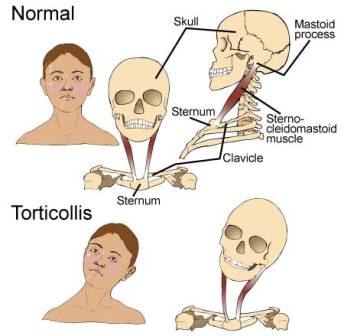Torticollis: Torticollis is disorders that exhibit flexion, extension, or twisting of the neck muscles beyond their normal position. The condition can either develop slowly if you have a family history of the disorder, or direct from trauma, or as an adverse reaction to medications.

When the disorder occurs in people with a family history, it is referred to as spasmodic torticollis (cervical dystonia). The characteristic twisting of the neck is initially spasmodic and begins between 30-45 years of age. If it is untreated, it likely will become permanent. Benign paroxysmal torticollis of infancy is a rare medical disturbance in infants distinguished by recurrent attacks of tilting of the head to one side.
The most common case has no definite cause, medications and therapies can alleviate pain and stiffness. Surgery can also sometimes correct the condition. In congenital torticollis, the sternocleidomastoid muscle is tight and shortened. For maximum children, stretching exercises and simple modifications in how the infant is held or positioned will progressively extend the muscle and correct the problem.
Causes of Torticollis/Wryneck
Anyone can acquire a wry neck after a muscle or nervous system trauma. In adults, acute torticollis can be caused by many different conditions. Wry neck can be inherited. It can also develop in the womb. However, most of the time, the cause of wry neck is unknown. This may happen if your baby’s head is in the wrong position. It can likewise be due to damage to the muscles or blood supply to the neck.
Certain commonly prescribed neuroleptic drugs such as prochlorperazine, haloperidol, and chlorpromazine can cause acute dystonia. This is a situation that affects the sudden onset of involuntary contractions of the muscles of the face, neck, or back.
Rarely, tumors, scar tissue, arthritis of the cervical spine, or vascular abnormalities may also cause torticollis.
Symptoms and Signs of Torticollis
Symptoms of wry neck can begin slowly. They may also worsen over time. The most common symptoms include:
- Adult torticollis, also known as cervical dystonia, presents as the rotation of the head or chin towards the shoulder. Neck muscles and those between the neck and shoulder will be tense and tender, causing neck pain.
- Swollen neck muscles
- Having one shoulder higher than the other.
Other symptoms may include Neck pain, tight sternocleidomastoid muscle, occasional formation of a mass, tenderness on the cervical spine, tremor in the head and decreased neck movement.
Types of torticollis
Congenital muscular torticollis- The congenital muscular torticollis is the most common torticollis which presents at birth.
Temporary torticollis-This type of wry neck usually disappears after one or two days.
Acquired torticollis-Disease of cervical vertebrae, adenitis, tonsillitis, rheumatism, enlarged cervical glands, retropharyngeal abscess, or cerebellar tumors.
Muscular torticollis- It results from scarring or tight muscles on one side of the neck.
Klippel-Feil syndrome-It occurs when the bones in your baby’s neck form incorrectly, notably due to two neck vertebrae being fused together.
Cervical dystonia-It makes neck muscles to get in spasms. If you have cervical dystonia, the head twists or turns achingly to one side.
Torticollis Diagnosis
Your physician will want to take your medical history and perform a comprehensive physical examination and check for other conditions that can cause torticollis symptoms.
An electromyogram (EMG) measures electrical activity in your muscles. It can determine which muscles are affected.
Imaging tests, such as x-rays and ultrasound scans or MRI scans can also be used to find structural problems that might be causing your symptoms.
Treatment for Torticollis
Treatment concerning torticollis is targeted to loosen the contracted neck muscles involved. Initially, the condition is handled with physical therapies, such as stretching to release tightness, neck braces, massage and strengthening exercises to improve muscular balance.
Medications can be helpful. They can include:
- Muscle relaxants
- Pain medications
- Botulinum toxin injections repeated every few months
In most people, torticollis resolves in several days to a few weeks. A few people will develop continuing neck problems for months to years. Persistent neck muscle spasms may require referral to a neurologist or surgeon. Your doctor may recommend surgery-
- Lengthening neck muscles
- Fusing abnormal vertebrae
- Cutting nerves or muscles
- Using deep brain stimulation to interrupt nerve signals

